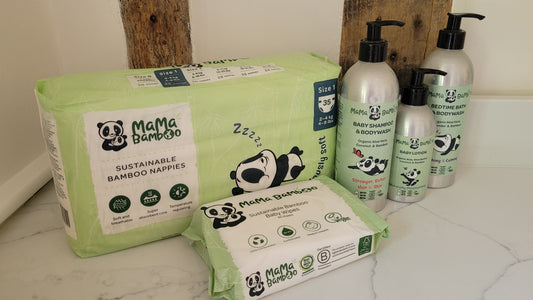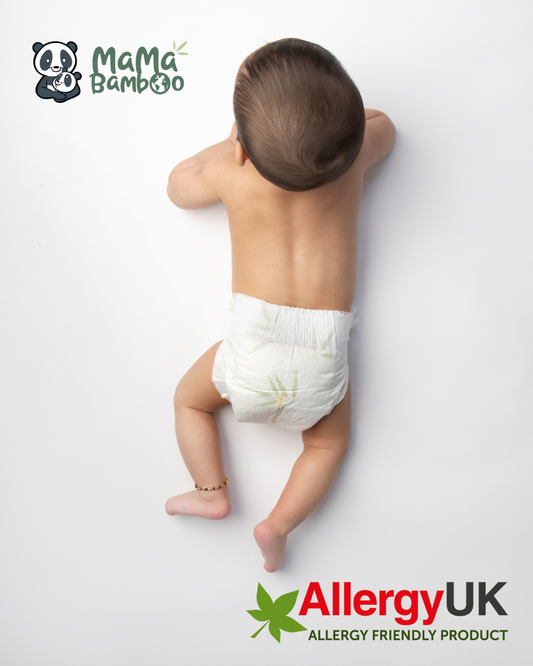As new parents in the UK, one of the biggest surprises is just how much there is to learn about nappies. Your baby’s poo will change constantly in the early months, from colour and texture to smell and frequency. Understanding what’s normal can bring real peace of mind. This guide, based on NHS advice and trusted parenting resources, will help you know what to expect, what to watch for, and when to call your GP. However if you are concerned, or things just don’t look right, then trust your gut and seek advice from your midwife, health visitor or GP.
What is meconium and when should my baby pass it?
Your baby’s first poo, called meconium, usually appears within the first 24 to 48 hours after birth (NHS, 2023). It appears black or dark green, thick, and sticky, resembling tar more than anything else. Meconium is a good sign that your baby’s digestive system is working properly and ready to start processing milk. If your baby hasn’t passed meconium after 48 hours, let your midwife or GP know, as this could indicate a blockage that needs checking. Using warm water and cotton wool instead of wipes in the early days makes cleaning easier since meconium tends to cling stubbornly to the skin.
Where does baby poo go in the womb?
This is a question many parents ask, and it’s an interesting one. While in the womb, your baby doesn’t actually need to poo because their nutrition comes directly from the placenta. However, they do swallow amniotic fluid, skin cells, and other materials that later form meconium. In most cases, babies don’t release this until after birth. Occasionally, a baby may pass meconium before delivery, which can mix with the amniotic fluid. If this happens, midwives and doctors will monitor the baby closely for any signs of meconium aspiration, which occurs when the baby inhales the fluid. Thankfully, this is rare and usually handled quickly and safely by healthcare professionals.
How does baby poo change in the first few weeks?
After the meconium clears, your baby’s poo will gradually become lighter and softer. For breastfed babies, it often turns a mustard-yellow colour and becomes runny, sometimes with tiny seeds. This stage can involve frequent changes, often after every feed, which is completely normal. Formula-fed babies tend to have thicker, more formed stools that are tan, yellow-brown, or light brown, and usually smell a little stronger. These differences simply reflect how each type of milk digested in the body.
What does normal baby poo look like?
There is a surprisingly wide range of what counts as normal when it comes to baby poo. It can be yellow, green, or brown, runny or pasty, and vary in smell from mild to quite strong. The key thing to remember is that consistency and comfort matter more than colour. If your baby seems happy, is feeding well, and gaining weight, then small variations are usually harmless.
How often should my baby poo?
There’s no single answer to how often a baby should poo. Some newborns pass stool after every feed, while others might only go once every few days. Breastfed babies can go several days without pooing once their bodies have adjusted, while formula-fed babies tend to be more regular. The NHS advises that what really matters is your baby’s comfort, appetite, and weight gain. If the stool is soft and your baby isn’t straining, infrequent bowel movements aren’t necessarily a cause for concern.
Why does breastfed baby poo look different from formula-fed poo?
Breast milk is perfectly digestible for babies, so breastfed poo is naturally softer, looser, and often described as “seedy.” It’s also less smelly. Formula-fed baby poo tends to be thicker and closer in texture to peanut butter, with a stronger odour. Both are normal and healthy, simply reflecting the differences in digestion between breast milk and formula. But remember there is no right or wrong with feeding babies, a fed baby is a happy baby, whether it is breast or formula milk.
What baby poo colours should I worry about?
Most baby poo colours are harmless. However, the NHS recommends contacting your GP if your baby’s poo is red, black (after meconium has passed), or very pale, white, or grey. Red may indicate blood, while pale or chalky stools could suggest a problem with the liver or bile flow. Any of these colours should be checked quickly. Otherwise, yellows, browns, and greens are completely normal and may shift slightly due to variations in feeding patterns, iron supplements, or mild gastrointestinal issues.
Why does my baby have green poo?
Green poo can be alarming, but it’s usually harmless. It often occurs due to iron supplements, changes in diet, or an imbalance between foremilk and hindmilk during breastfeeding. If your baby is healthy, feeding well, and the green poo comes and goes, there’s no need to worry. If it persists, becomes watery, or your baby seems unsettled, contact your GP.
What is constipation in babies and how can I help?
Constipation happens when your baby’s poo becomes hard, dry, or pellet-like, and they strain or cry when passing it. Gentle tummy massages, moving your baby’s legs in a cycling motion, or giving extra fluids (if your baby is old enough) can help alleviate discomfort. Formula-fed babies may benefit from small adjustments in preparation ratios, but always follow NHS guidance. If constipation persists, it’s best to consult your GP for advice before trying any remedies.
What is diarrhoea in babies and when should I call a doctor?
Diarrhoea means very watery poo that happens more often than usual. Because babies can become dehydrated quickly, it’s important to call your GP or NHS 111 if diarrhoea lasts longer than 24 hours, if your baby has a fever or vomiting, or if you notice blood or mucus in the stool. Signs of dehydration include fewer wet nappies, a dry mouth, and unusual sleepiness.
How to get baby poo out of clothes
Baby poo stains can be stubborn, but there are a few simple tricks to help remove them. Rinse or soak the affected area in cold water as soon as possible, since hot water can set the stain. Next, use a mild, baby-safe detergent, such as Napisan, or a small amount of baking soda to lift the residue. For tough stains, hanging the garment in direct sunlight can help naturally bleach it. Avoid harsh chemicals or strong stain removers, as these can irritate your baby’s skin.
When will baby poo start to look more like adult poo?
Around six months, when babies start eating solids, you’ll notice a big change in their nappies. The poo will become firmer, darker, and smellier, and sometimes you’ll even spot bits of undigested food. This is normal, as your baby’s digestive system is still developing.
Common myths about baby poo
There are many myths about baby poo that can confuse even experienced parents. One common myth is that teething causes diarrhoea. While teething can cause extra drooling, which may make stools looser, persistent watery diarrhoea is usually due to infection and should be checked by your GP. Another myth is that formula-fed babies must poo daily, which isn’t true. Some healthy formula-fed babies can go longer without discomfort.
You may also hear that green poo always means illness, but in most cases, it’s perfectly normal, often linked to diet or iron intake. Finally, while breastfed babies are less likely to experience constipation, they can still develop it. Understanding what’s true and what’s not can save you many anxious moments and unnecessary doctor visits.
What wipes and nappies are best for sensitive baby bottoms?
The NHS advises avoiding wipes and nappies with harsh fragrances or chemicals, as newborn skin is extremely delicate. Eco-friendly options, such as bamboo-based nappies and wipes, are softer and more breathable, helping to prevent irritation. Choosing gentle, sustainable products like those from Mama Bamboo protects your baby’s skin while reducing your environmental footprint.
When to call your GP about baby poo
You should contact your GP if your baby has very pale, grey, or white poo, blood in their stool, ongoing constipation, or diarrhoea that lasts more than 24 hours. Also call if your baby seems unusually sleepy, unwell, or is refusing feeds. Trust your instincts — if something feels off, it’s always better to check. NHS 111 is available 24/7 for reassurance and advice.
Baby poo might not be the most glamorous part of parenthood, but it’s one of the best indicators of your child’s health and well-being. From the sticky meconium in those first days to the new textures after introducing solids, nappies tell a story of growth, development, and digestion. Most variations are completely normal, and understanding what to expect will help you feel calmer and more confident.
As you navigate these early months, remember that using soft, eco-friendly nappies and wipes can make a real difference for your baby’s comfort and for the planet. Parenthood is full of surprises, but one thing is certain: every nappy change brings you closer to understanding your baby and the incredible journey you’re both on.
References
● NHS: Your baby’s nappies
● NHS: Constipation in babies
● NHS: Diarrhoea and vomiting in babies
● NHS: Your baby’s first few days
● NHS: Colic in babies





